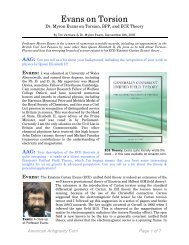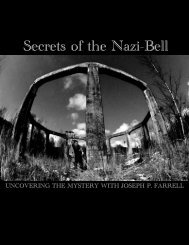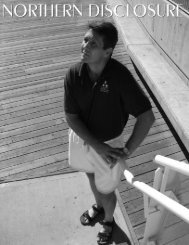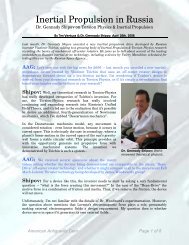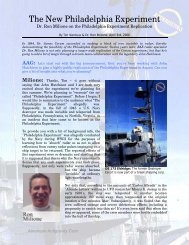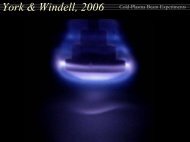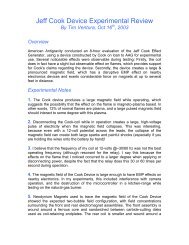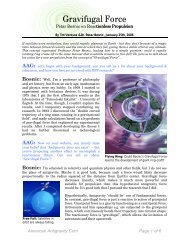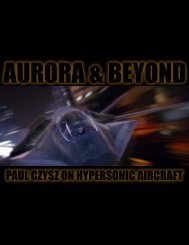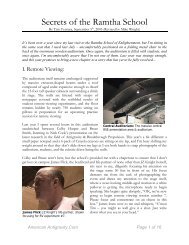Podkletnov-Interview.. - American Antigravity
Podkletnov-Interview.. - American Antigravity
Podkletnov-Interview.. - American Antigravity
Create successful ePaper yourself
Turn your PDF publications into a flip-book with our unique Google optimized e-Paper software.
<strong>Podkletnov</strong>: That’s an interesting question…and to our great surprise the beampractically does not lose energy when it meets the materials. It can pass through a brick wall orconcrete, or metal-plates – very thick ones – or plastics also, and it seems that it doesn’t loseenergy at all. This is the consistent, long-term evidence from a lot of test discharges weperformed at an installation I’ve been working at for about 4 years.These results seem a bit strange, but we don’t believe we’re breaking any natural laws…simplythat the system we’re working in is not a closed one, and therefore the second law ofthermodynamics is not applicable in the traditional sense.In terms of action at a distance – and the dependence of distance on the beam energy – we don’thave much experimental data, but what we do have is a first measurement at a distance of 1.2kilometers without any loss in energy. Our latest experiment was conducted over a distance of 5kilometers, and the beam penetrated through several houses made of concrete. We did notmeasure any loss of energy, but after closely evaluating some of the calculations that we’vemade, we should get some decrease in beam-energy at distances greater than 100 kilometers.This is research that awaits us in the future.AAG: You’d mentioned 5 kilometers –did you notice any change in the focus of thebeam. Did it widen or perhaps get smalleras it travels?<strong>Podkletnov</strong>: If the main solenoidwhich is wound around the chamber ismade in a good way, then we have a verygood discharge and it effectively maintainsa non-divergent cross-sectional pattern ofthe emitter it was projected from. However,at a distance of 5 kilometers, the beambegins to lose focus– it gets a bit wider thanit was, indicating minor deviations in theshape of the impulse as it propagates.AAG: I collected a few questions online,and one person wrote me, “Is it possible togenerate more work along the path of thebeam than energy put into the beam?” Ithink they were asking about potential“over-unity” applications.<strong>Podkletnov</strong>: It’s been surprising tofind that the energy that we put into thedischarge is much less than the energy thatthe impulse seems to generate, but itdoesn’t mean that it’s an over-unity device,simply that we’re creating a set of specialspace-time conditions through theinteractions of the electromagnetic pulsedischargewith the bose-einstein condensate(superconductor). By manipulating theseDischarge Chamber: A complete layout-schematicof the chamber showing experimental components.<strong>American</strong> <strong>Antigravity</strong>.Com Page 4 of 13



